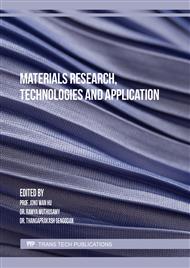[1]
A. Ahmad, et al. Green sago starch nanoparticles as reinforcing material for green composites. Polymer 202 (2020) 122646.
DOI: 10.1016/j.polymer.2020.122646
Google Scholar
[2]
H. Kim, et al. Preparation, characterization and utilization of starch nanoparticles (Review). Colloids and Surfaces B: Biointerfaces 126 (2015) 607–620.
DOI: 10.1016/j.colsurfb.2014.11.011
Google Scholar
[3]
X. Wang, et al. Research advances in chemical modifications of starch for hydrophobicity and its applications: A review. Carbohydr. Polym. 240 (2020) 116292.
Google Scholar
[4]
E. Ojogbo, et al. Chemical and physical modifications of starch for renewable polymeric materials. Mater. Today Sustain. 7-8 (2020) 100028.
DOI: 10.1016/j.mtsust.2019.100028
Google Scholar
[5]
P. Campelo, et al. Starch nanoparticles: production methods, structure, and properties for food applications. Curr. Opin. Food Sci. 33 (2020) 136–140.
Google Scholar
[6]
D. LeCorre, and H. Angellier-Coussy. Preparation and application of starch nanoparticles for nanocomposites: A review. React. Funct. Polym. 85 (2014) 97–120.
DOI: 10.1016/j.reactfunctpolym.2014.09.020
Google Scholar
[7]
L. Velásquez-Castillo, et al. Quinoa starch nanocrystals production by acid hydrolysis: Kinetics and properties. Intl J Biological Macromolecules 143 (2020) 93–101.
DOI: 10.1016/j.ijbiomac.2019.12.011
Google Scholar
[8]
D. Le Corre, E. Vahanian, A. Dufresne & J. Bras (2012). Enzymatic Pretreatment for Preparing Starch Nanocrystals. Biomacromolecules, 13(1):132-137.
DOI: 10.1021/bm201333k
Google Scholar
[9]
N.L. Garcia, L. Ribba, A. Dufresne, M. Aranguren & S. Goyanes. Effect of glycerol on the morphology of nanocomposites made from thermoplastic starch and starch nanocrystals. Carbohydr. Polym., 84 (2011) 203-210.
DOI: 10.1016/j.carbpol.2010.11.024
Google Scholar
[10]
N. L. Vanier, et al. Molecular structure, functionality and applications of oxidized starches: A review. Food Chem. 221 (2017) 1546–1559.
DOI: 10.1016/j.foodchem.2016.10.138
Google Scholar
[11]
A.R.G. Dias, et al. Oxidation of fermented cassava starch using hydrogen peroxide. Carbohydr. Polym. 86 (2011) 185– 191.
Google Scholar
[12]
Y . Yu, et al. Preparation of highly-oxidized starch using hydrogen peroxide and itsapplication as a novel ligand for zirconium tanning of leather. Carbohydr. Polym. 174 (2017) 823–829.
DOI: 10.1016/j.carbpol.2017.06.114
Google Scholar
[13]
N. Tung, et al. The molecular structural transformation of jackfruit seed starch in hydrogen peroxide oxidation condition. J. Indian Chem. Soc. 98 (2021) 100192.
DOI: 10.1016/j.jics.2021.100192
Google Scholar
[14]
A. Mukurumbira, et al. Microstructure, thermal properties and crystallinity of amadumbe starch nanocrystals, Int. J. Biol. Macromol. (2017) http://dx.doi.org/10.1016/j.ijbiomac.2017.04.030.
Google Scholar
[15]
B. Gong, et al. Understanding Shape and Morphology of Unusual Tubular Starch Nanocrystals. Carbohydrate Polymers. (2016) http://dx.doi.org/10.1016/j.carbpol.2016.06.010.
DOI: 10.1016/j.carbpol.2016.06.010
Google Scholar
[16]
B. Wei, et al. Synthesis, characterization and hydrophobicity of silylated starch nanocrystal. Carbohydr. Polym. 136 (2016) 1203–1208.
DOI: 10.1016/j.carbpol.2015.10.025
Google Scholar
[17]
D. An, et al. Preparation, characterization, and application of high-whiteness agar bleached with hydrogen peroxide. Food Hydrocoll. 113 (2021) 106520.
DOI: 10.1016/j.foodhyd.2020.106520
Google Scholar
[18]
D. Pavia, et al. Introduction to Spectroscopy: A guide for Students of organic Chemistry. 3rd ed. Brooks/Cole, USA, (2001).
Google Scholar
[19]
E. Álvarez-Fernández, et al. Antimicrobial resistance in E. coli isolates from conventionally and organically reared poultry: A comparison of agar disc diffusion and Sensi Test Gram-negative methods. Food Control 30 (2013) 227-234.
DOI: 10.1016/j.foodcont.2012.06.005
Google Scholar



